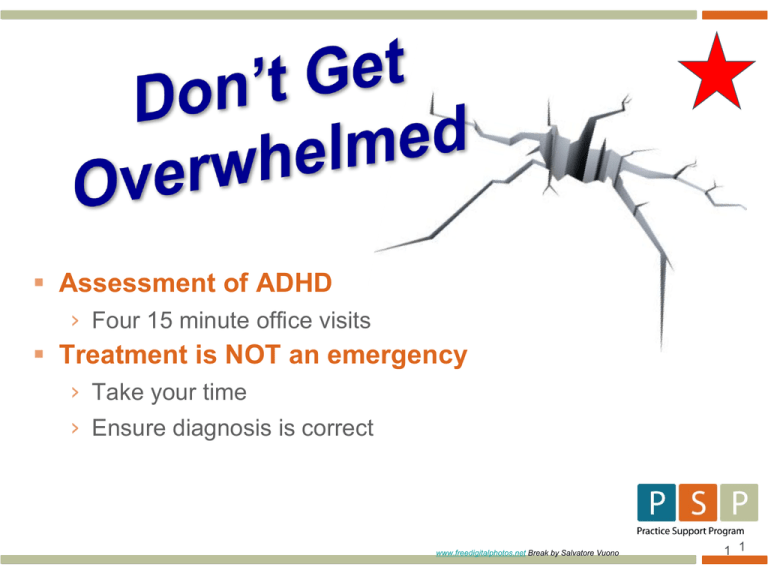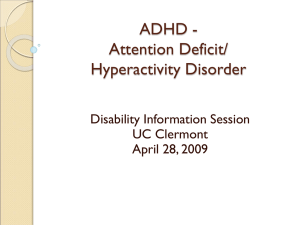Document
advertisement

Assessment of ADHD › Four 15 minute office visits Treatment is NOT an emergency › Take your time › Ensure diagnosis is correct www.freedigitalphotos.net Break by Salvatore Vuono 1 1 Assessment Tool SNAP-IV Teacher and Parent 18-item Rating Scale A norm-referenced checklist › Designed to determine presence of ADHD symptoms › Can be completed by a parent/caregiver or educator DSM-IV criteria for ADHD › Must be at least 6 responses of “Quite a Bit” or “Very Much” (scored 2 of 3) to either of the: 9 inattentive items, OR 9 hyperactive-impulsive items, OR Both on the 18-item rating scale 2 Assessment Tool SNAP-IV Teacher and Parent 18-item Rating Scale Young person must meet the following criteria: Some symptoms present before age 12 years Some impairment present in two or more settings › Social, academic or occupational Clear evidence of clinically significant impairment › In social or academic functioning › Must not be primarily due to any other factors or conditions Mood Disorder, Anxiety Disorder, Dissociative Disorders, Personality Disorder 3 Assessment Tool SNAP-IV Teacher and Parent 18-item Rating Scale Rating scale alone not sufficient to diagnose For diagnosis and clinical intervention must have: › Complete history › Appropriate physical examination Ensure DSM-V criteria is met 4 Assessment Tool SNAP-IV Teacher and Parent 18-item Rating Scale If a SNAP-IV score of 18 or higher: › Discuss important issues/problems in child’s/youth’s life/environment › Child Use the Child Functional Assessment (CFA) to determine impact on functioning › Youth: Screen for Depression Use the Kutcher Adolescent Depression Screen (KADS) Complete or use the Teen Functional Activities Assessment (TeFA) to determine the impact on functioning 5 Monitoring and Intervention Tools: ADHD Monitoring CGI TeFA / CFA TASR-A SNAP-IV Interventions (these do not replace medications or psychotherapies) PST WRP 6 Children Visit 1 Consider risk factors Apply screening tool Complete CFA Complete SNAP-IV Visit 2 SNAP-IV 18 item CFA Use PST and WRP If risk factors are substantial or if three or more positives answers on either the Parent or Child Version of the Screening Tool or CFA suggests dysfunction due to ADHD like symptoms - Use the Psychotherapeutic Support for Children (PSC) and Stress Reduction Prescription (WRP) (proceed to step 2 in 1 - 2 weeks.) Complete SNAP-IV. Provide SNAP-IV to parents and teachers. Provide information about ADHD and its treatment. Obtain informed consent to allow discussion with the school. If fewer than 3 positive answers on The Parent or Adolescent version of the Screening Tool - consider other possible explanations for signs/symptoms such as: environmental stressors, Oppositional Defiant Disorder, Conduct Disorder, Learning Disorder. Use the Psychotherapeutic Support for Children (PSC) and Worry Reduction Prescription (WRP) and monitor again in a month and repeat STEP I and review other possible psychiatric conditions. If SNAP-IV 18 > 18 (or a mean score of greater than 1) and CFA shows decrease in function - continue with PST and WRP strategies - proceed to step 3 within a week. Review SNAP-IV from parents and teachers for scores as above. Discuss ADHD and its treatment and encourage “google search”. If SNAP-IV 18 <18 (or a mean score of greater than 1) and shows no decrease in function – continue with PST and WRP strategies and monitor again in a month– advise to call if feeling worse or problems escalate. 7 Children Visit 3 SNAP-IV 18 CFA Use PST and WRP If SNAP-IV 18 remains > 18 (or a mean score of greater than 1) and CFA shows functioning problems – proceed to diagnosis (review DSM-V criteria) and treatment after discussion of ADHD and treatment options** If SNAP-IV 18 <18 (or a mean score of greater than 1) and CFA shows no decrease in function – continue with PST and WRP strategies - monitor again with SNAP-IV 18 and CFA in one month – advise to call if feeling worse or problems escalate. Consider Confident Parents: Thriving Kids. 8 www.freedigitalphotos.net Download Two Girls On A Swing by Naypong Youth Visit 1 Consider risk factors Apply screening tool TeFA SNAP-IV Visit 2 SNAP-IV 18 item TeFA Use PST and WRP If risk factors are substantial or if two or more positives answers on either the Parent or Adolescent Version of the Screening Tool or TeFA suggests dysfunction due to ADHD like symptoms - Use Psychotherapeutic Support for Teens (PST) and Stress Reduction Prescription (WRP) , see page 21 - proceed to step 2 in 1 - 2 weeks Provide SNAP-IV to parents and teachers (school contact can be through parents if feasible). Complete SNAP-IV 18. Provide information about ADHD and its treatment. Obtain informed consent to allow discussion with the school. If fewer than 3 positive answers on The Parent or Adolescent version of the Screening tool - consider other possible explanations for signs/symptoms such as: environmental stressors, Oppositional Defiant Disorder, Conduct Disorder, Learning Disorder. Use PST (see page 29) and WRP (see page 21) and monitor again in a month and repeat STEP I and review other possible psychiatric conditions. If SNAP-IV 18 > 18 (or a mean score of greater than 1) and TeFA shows decrease in function - continue with PST and WRP strategies proceed to step 3 within a week. Review SNAP-IV 18 from parents and teachers for scores as above. Discuss ADHD and its treatment and encourage “google search”. If SNAP-IV 18 <18 (or a mean score of greater than 1) and shows no decrease in function – continue with PST and WRP strategies and monitor again in a month– advise to call if feeling worse or problems escalate. 9 Visit 3 SNAP-IV 18 TeFA Use PST and WRP If SNAP-IV 18 remains > 18 (or a mean score of greater than 1) and TeFA shows decrease in function – proceed to diagnosis (review DSMV criteria) and treatment. If SNAP-IV 18 <18 (or a mean score of greater than 1) and TeFA shows no decrease in function – continue with PST and WRP strategies - monitor again with SNAP-IV 18 and TeFA in one month – advise to call if suicide thoughts or acts of self-harm occur or if problems escalate. freedigitalphotos Sujin Jetkasettakorn Youth 10 Co-morbidity in ADHD Approx. 30 – 50% of people with ADHD have other psychiatric disorders › Oppositional Defiant Disorder (ODD) › Conduct Disorder (CD) › Learning Disorder › Disruptive Mood Dysregulation Disorder Discuss academic and behavioral performance › With teachers and guidance counselor › Address possibility of a learning disability › Specialized learning assessments through school Develop treatment plan for each disorder › Address ADHD first as other disorder often improves as ADHD improves 11 Co-morbidity in ADHD Begin treatment Refer child/youth to specialty services or Stronger Families › For more intensive behavioral or family interventions › Many with ADHD co-morbid with ODD, CD, LD, DMDD, MDD require specialty services › Primary care provider should be part of the treatment plan If learning disability is suspected: › Refer for educational psychological testing › Contact school › Remedial learning strategies › Informed written consent to contact school 12 www.freedigitalphotos.net by Salvatore Vuono Confident Parents: Thriving Kids Evidence-based, family-focused coaching intervention for parents Effective in preventing, reducing and reversing mild to moderate behavioural problems for children aged 3-12 Coaching delivered via telephone at no cost to patients Operational hours include evenings and weekends Physician referral required (form in your binder) Offered by the Canadian Mental Health Association – BC Division 13 Table Discussion Which of these tools or techniques discussed do you currently use? How do you see this fitting into your context? How can non-clinician team members contribute to administration and completion of the tools? 14 appendix – optional slides 15 Canadian Attention Deficit Hyperactivity Disorder Resource Alliance (CADDRA) www.pspbc.ca CADDRA A national, independent, not-for-profit association. The voice of doctors who support patients with Attention Deficit Hyperactivity Disorder (ADHD) and their families. 17 CADDRA Vision To improve the quality of life and reduce the suffering of patients with ADHD and their families while maximizing their potential across the lifespan. 18 CADDRA Mandate CADDRA is a national Canadian alliance of professionals working in the area of ADHD who are dedicated to world class research, education, training and advocacy in the area of ADHD. 19 CADDRA Information for physicians, parents, educators, children, adolescents, and adults 20 CADDRA Canadian ADHD Practice Guidelines Third Edition (2011): Download Diagnosis and Overview of Visits Differential Diagnosis and Comorbid Disorders Specific Issues in the Management of Children with ADHD: Intervention with Parents of Children Diagnosed with ADHD Specific Issues in the Management of Adolescent ADHD Specific Issues in the Management of ADHD in Adults Psychosocial Interventions and Treatments Pharmacological Treatment of ADHD CADDRA ADHD Assessment Toolkit (CAAT) 21 CADRRA Tools www.caddra.ca Assessment and Follow-up Forms: Handouts › CADDRA ADHD Assessment Form › Weiss Symptom Record (WSR) › ADHD Checklist › SNAP-IV-26 › CADDRA ADHD Information and Resources › CADDRA Child Assessment Instructions › CADDRA Adolescent › Adult ADHD Self-Report Scale (ASRS) Assessment Instructions › Weiss Functional Impairment Rating Scale Parent Report (WFIRS-P) › –CADDRA Adult Assessment › Weiss Functional Impairment Rating Scale –Instructions Self Report (WFIRS-S) › CADDRA Teachers Instructions › CADDRA Teacher Assessment Form › CADDRA Clinician ADHD Baseline/Follow-Up Form › CADDRA Patient ADHD Medication Form 22 WSR 23 Teacher Assessment 24 WSIRS-P 25 WFIRS-S 26 ADHD Checklist 27 ADHD Assessment Form 28 Teacher Instructions 29 CADDRA Medication Tables 30 Patient ADHD 31







